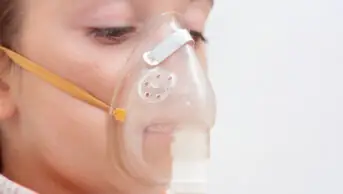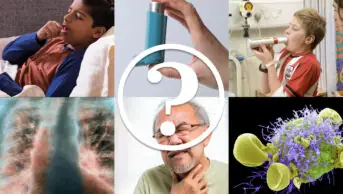
Shutterstock.com
The quality of our air is currently under scrutiny and is becoming a widely felt public and professional concern, with mainstream media outlets, such as The Guardian stating that it is a “public health emergency”[1]
.
The UK government is also under pressure after being taken to the High Court for the third time in recent years for consistently breaching certain pollutant limits and failing to comply with the EU Ambient Air Quality Directive[2]
. It is therefore important to understand the health concerns and implications that surround air pollution.
Global perspective
Air pollution is not solely a UK-based concern but is increasingly being viewed as a global problem, with 85% of the world’s population living in areas that exceed the World Health Organization’s specified maximum limit pollution levels[3]
. Air pollution was recently ranked seventh within the leading risk factors for mortality and was the principal health-related environmental risk factor, with three million deaths globally attributable to outdoor air pollution[4]
.
Obtaining an exact figure for the number of deaths related to air pollution is complex, primarily because it is not a recordable cause of death and therefore figures are generated from calculations of health statistics. The Committee on the Medical Effects of Air Pollutants (COMEAP), the body that advises the UK government on matters concerning health effects of air pollution, suggests that a total of 340,000 years of life are lost each year due to air pollution[5]
. This equates to an estimate of reducing an individual’s life expectancy by nine months if he or she was exposed throughout his or her lifetime to the levels of ambient air pollution as seen in 2010[6]
.
Air pollution and its effects on health
Air pollution is a broad term for a range of particles and gases that can arise from both biological and man-made sources. The contaminants within the air are dependent on that particular environment, differing according to the source of the pollutants. Outdoor air pollutants are diverse but three of the most current significant health-related constituents are particulates, nitrogen oxides and ozone[7]
.
The sources of outdoor pollutants principally include industrial and road traffic emissions, deriving from burning fossil fuels. Road-traffic emissions contribute significantly to outdoor air pollution in the UK. Diesel-powered vehicles emit more nitrogen oxides and particulates than petrol-powered vehicles. In London, it was estimated that 40% of nitrogen oxide levels were due to diesel vehicle emissions[8]
. An important factor has been the growth in the number of diesel-powered vehicles present on the roads within the EU. Following incentives initiated by the governments within the EU, the proportion of the total number of diesel-powered vehicles present on Europe’s roads increased from 10% in the 1990s to 35.3% by 2010. Of the newly registered vehicles in 2011, 58% were diesel fuelled[9]
.
The impact that air pollution has upon a child’s health has the potential to affect their well-being negatively into adulthood and, therefore, any improvements will have both short- and long-term benefits
An emerging premise is that air pollution is a stressor that interacts with various individual-based factors, resulting in poor health and increased disease susceptibility[7]
. Therefore, the effect of pollution can impact the health of a person at every life stage, with particular population groups being more vulnerable, mainly the extreme ages or co-existing chronic health complaints such as cardiovascular and respiratory disease.
The key message within the Royal College of Physician’s 2016 report, ‘Every breath we take’, is that air pollution has an effect over a lifetime; from inter-utero through to older age. The impact that air pollution has upon a child’s health has the potential to affect their well-being negatively into adulthood and, therefore, any improvements will have both short- and long-term benefits[7]
.
A potential mechanism by which air pollution contributes to poor health is through the concept of oxidative stress. The constituents within air pollution can react and cause free radicals to be formed. These are highly volatile and, when exposed to the lung epithelium, a series of reactions occur at the cellular level, resulting in tissue damage and inflammation[10]
. It is this process of oxidative stress that is postulated to cause some of the negative respiratory and cardiovascular effects of air pollution.
The effect of pollution can impact the health of a person at every life stage, with particular population groups being more vulnerable, mainly the extreme ages or co-existing chronic health complaints such as cardiovascular and respiratory disease
There has been a considerable drive to understand both the short- and long-term health effects of pollution. For example, there is good evidence that air pollution can act as an irritant and trigger an acute exacerbation of an existing chronic lung condition such as asthma or chronic obstructive pulmonary disease[11]
,[12]
. The Framingham Heart Study found that short-term increases in the exposure of particulates, ozone and nitrogen oxides were related to reduced lung function in adults without a respiratory condition[13]
.
Longer-term health effects have been explored through longitudinal studies. In 1993, a prospective cohort study of 8,111 individuals from six different communities within the United States were examined and, after adjusting the co-founding risk factors such as cigarette smoking, found that there was a strong association between mortality and the level of fine inhalable pollutants[14]
. Further epidemiological studies found that particulate air pollution was associated with cardiopulmonary and lung cancer mortality[15]
.
The European Study of Cohorts for Air Pollution Effects (ESCAPE) project identified that nitrogen oxides at a higher level were associated with a reduced forced expiratory volume in one second (FEV1)[16]
. The ESCAPE project has produced many other studies that suggest an association between air pollution and ill health, such as particulates contributing to the incidence of lung cancer, strengthening the classification of air pollution and particulates as carcinogenic by the International Agency for Research on Cancer[7]
.
Longitudinal studies have also identified an association of higher exposure to nitrogen oxides and particulates with new-onset asthma[17]
, type 2 diabetes[18]
, cognitive decline[19]
and cardiovascular disease increasing.
In a review of multi-city epidemiological studies, Langrish identified a relationship between air pollution level and cardiovascular disease with a 0.5–2% increase in cardiovascular-related mortality with each 10–20mcg/m3 increase in particulate air pollution exposure[20]
.
Children are particularly vulnerable to the respiratory effects of pollution due to their narrower airways and the relative exposure of air to body weight[21]
.
In the Children’s Health Study, an 11,000 cohort across California, USA, lung growth was found to be suppressed in those living in areas with higher concentrations of nitrogen oxides and particulates[22]
. A similar finding was seen in the Framingham Heart Study looking at long-term exposure of particulates, with higher exposure levels being associated with reduced lung function in adults[23]
.
One of the most important findings from a public health initiative viewpoint is that air pollution exposure reduces lung growth in children[24]
. This is important because reduced lung growth, characterised by a lower FEV1, is associated with an increased risk of a child developing asthma[25]
, as well as increasing risk of mortality in later life[26]
. In the Children’s Health Study, Gauderman et al showed that improved air quality, specifically reduced particulates and nitrogen dioxide concentration, was associated with improved lung-function growth that was statistically and clinically significant. They suggested that a modest improvement in air quality can lead to improved health[24]
.
For healthcare providers like pharmacists, the main opportunity is to identify and advise patients with relevant health conditions on strategies to reduce their risk of adverse effects during high pollution episodes
Interventions and policies
National Institute for Health and Care Excellence (NICE) guidance on outdoor air pollution and health (published in June 2017) highlighted the need for all tiers of government to consider policies in town planning that would help to improve the air quality, primarily by reducing the number of polluting vehicles on the road[27]
. The guidance suggested improving infrastructure for alternative transportation means, such as cycle route, walking routes and electric vehicle charging hubs. It also promoted ideas of mitigating the impact of air pollution in areas where there is high traffic volume such as incorporating travel plans to reduce the number of motorised trips, such as car clubs and creating a low emission zone[27]
.
A low emission zone (LEZ) is an example of a strategy to control traffic emissions within a defined area where polluting vehicles have restricted access or are financially penalised. This strategy has been applied across different European cities. The 2017 NICE guidance supported different methods to create ‘Clean Air Zones’, with the ultimate aim for the restrictions to traffic or emission to be applied to a wider geographical area rather than focusing only on a pollution hot-spot[27]
. An extension of a LEZ is the Ultra Low Emission Zone (ULEZ) which is planned to be implemented in central London from September 2020. The proposed ULEZ will extend the fiscal charges within the existing Congestion Charge Zone of Central London, to encourage only vehicles that meet the ULEZ emission standard to be on the road[28]
.
Action for healthcare professionals consulting with patients
For healthcare providers like pharmacists, the main opportunity is to identify and advise patients with relevant health conditions on strategies to reduce their risk of adverse effects during high pollution episodes.
A key information source is the UK Air Quality Index which forecasts pollution levels using a simple traffic-light system; green indicating low levels of air pollution, amber for moderate levels and red warning high levels of air pollution[29]
. This forecast can then direct individuals to make adjustments to their potential exposure of air pollution by avoiding strenuous activities outside and ensuring they carry any reliever medication with them.
There are smartphone apps relevant for certain areas, such as the ‘City Air’ and ‘London Air’ apps, to help guide the user on pollution levels and routes that are lower in pollution exposure[30]
.
For healthcare professionals, the options available to mitigate the effect of air pollution for patients are suboptimal. Avoidance is not always possible or practical. Ultimately the key advance will be to reduce ambient air pollution levels.
The quality of our air is vital with a growing body of evidence strengthening the argument for reducing concentrations of air pollutants. Poor air quality is a contributor to a wide range of adverse effects, affecting people over their life course. It is modifiable but control is dependent upon a concerted effort from all levels of authority, at international, governmental, regional and local levels.
Lois Holliday is an Honorary Research Fellow in the Blizard Institute, Centre for Primary Care and Public Health within the School of Medicine & Dentistry, Queen Mary University of London and a GP Registrar within City & Hackney, London. Correspondence to: l.holliday@qmul.ac.uk
References
[1] Carrington D. MPs: UK air pollution is a ‘public health emergency’. The Guardian. 27 April 2016. Available at: https://www.theguardian.com/environment/2016/apr/27/uk-air-pollution-public-health-emergency-crisis-diesel-cars (accessed September 2017)
[2] Bolton D. Air pollution is now a global ‘public health emergency’, according to the World Health Organization: The Independent. 19 January 2016 Available at: http://www.independent.co.uk/environment/air-pollution-public-health-emergency-who-world-health-organisation-a6821256.html (accessed September 2017)
[3] Forouzanfar MH, Alexander L, Anderson HR et al. Global, regional, and national comparative risk assessment of 79 behavioural, environmental and occupational, and metabolic risks or clusters of risks in 188 countries, 1990–2013: a systematic analysis for the Global Burden of Disease Study 2013. Lancet 2015;386(10010):2287–2323. doi: 10.1016/S0140-6736(15)00128-2
[4] World Health Organization. Burden of disease from air pollution for 2012: summary of results. Geneva; WHO. 2014. Available at: http://www.who.int/phe/health_topics/outdoorair/databases/FINAL_HAP_AAP_BoD_24March2014.pdf (accessed September 2017)
[5] Committee on the Medical Effects of Air Pollutants. The mortality effects of long-term exposure to particulate air pollution in the United Kingdom. London: Health Protection Agency; 2010. Available at: http://www.gov.uk/government/publications/comeap-mortality-effects-of-long-term-exposure-to-particulate-air-pollution-in-the-uk (accessed September 2017)
[6] Walton H, Dajnak D, Beevers S et al. Understanding the health impacts of air pollution in London. King’s College London; 2015. Available at: https://www.london.gov.uk/sites/default/files/hiainlondon_kingsreport_14072015_final.pdf (accessed September 2017)
[7] Royal College of Physicians. Every breath we take: the lifelong impact of air pollution. Report of a working party. London: RCP; 2016. Available at: https://www.rcplondon.ac.uk/projects/outputs/every-breath-we-take-lifelong-impact-air-pollution (accessed September 2017)
[8] Laybourn-Langton L, Quilter-Pinner H & Ho H. Lethal and illegal: solving London’s air pollution crisis. IPPR: Institute for Public Policy Research; 2016. Available at: https://www.ippr.org/publications/lethal-and-illegal-solving-londons-air-pollution-crisis (accessed September 2017)
[9] Cames M & Helmers E. Critical evaluation of the European diesel car boom — global comparison, environmental effects and various national strategies. Environ Sci Eur 2013;25:15. doi: 10.1186/2190-4715-25-15
[10] Kelly FJ & Fussell JC. Linking ambient particulate matter pollution effects with oxidative biology and immune responses. Ann NY Acad Sci 2015;1340:84–94. doi: 10.1111/nyas.12720
[11] Guarnieri M, Balmes JR. Outdoor air pollution and asthma. Lancet 2014;383(9928):1581–1592. doi: 10.1016/S0140-6736(14)60617-6
[12] Orellano P, Quaranta N, Reynoso J et al. Effect of outdoor air pollution on asthma exacerbations in children and adults: systematic review and multilevel meta-analysis. PLoS One 2017;12(3):e0174050. doi: 10.1371/journal.pone.0174050
[13] Rice MB, Ljungman PL, Wilker EH et al. Short-term exposure to air pollution and lung function in the Framingham Heart Study. Am J Respir Crit Care Med 2013;188(11):1351–1357. doi: 10.1164/rccm.201308-1414OC
[14] Dockery DW, Pope CA, Xu X et al. An association between air pollution and mortality in six U.S. cities. N Engl J Med 1993;329(24):1753–1759. doi: 10.1056/NEJM199312093292401
[15] Pope CA, Thun MJ, Namboodiri MM et al. Particulate air pollution as a predictor of mortality in a prospective study of U.S. adults. Am J Respir Crit Care Med. 1995;151(3 Pt 1):669–674. doi: 10.1164/ajrccm/151.3_Pt_1.669
[16] Adam M, Schikowski T, Carsin AE et al. Adult lung function and long-term air pollution exposure. ESCAPE: a multicentre cohort study and meta-analysis. Eur Respir J 2015;45(1):38–50. doi: 10.1183/09031936.00130014
[17] Young MT, Sandler DP, DeRoo LA et al. Ambient air pollution exposure and incident adult asthma in a nationwide cohort of U.S. women. Am J Respir Crit Care Med 2014;190(8):914-921. doi: 10.1164/rccm.201403-0525OC
[18] Coogan PF, White LF, Jerrett M et al. Air pollution and incidence of hypertension and diabetes mellitus in black women living in Los Angeles. Circulation 2012;125(6):767–772. doi: 10.1161/CIRCULATIONAHA.111.052753
[19] Ailshire JA & Crimmins EM. Fine particulate matter air pollution and cognitive function among older US adults. Am J Epidemiol 2014;180(4):359–366. doi: 10.1093/geronb/gbu064
[20] Langrish JP, Bosson J, Unosson J et al. Cardiovascular effects of particulate air pollution exposure: time course and underlying mechanisms. J Intern Med 2012;272(3):224–239. doi: 10.1111/j.1365-2796.2012.02566.x.
[21] Gasana J, Dillikar D, Mendy A et al. Motor vehicle air pollution and asthma in children: a meta-analysis. Environ Res 2012;117:36–45. doi: 10.1016/j.envres.2012.05.001
[22] Gauderman WJ, Avol E, Gilliland F et al. The effect of air pollution on lung development from 10 to 18 years of age. N Engl J Med 2004;351(11):1057–1067. doi: 10.1056/NEJMoa040610
[23] Rice MB, Ljungman PL, Wilker EH et al. Long-term exposure to traffic emissions and fine particulate matter and lung function decline in the Framingham Heart Study. Am J Respir Crit Care Med 2015;191(6):656–664. doi: 10.1164/rccm.201410-1875OC
[24] Gauderman WJ, Urman R, Avol E et al. Association of improved air quality with lung development in children. N Engl J Med 2015;372(10):905–913. doi: 10.1056/NEJMoa1414123
[25] Islam T, Gauderman WJ, Berhane K et al. Relationship between air pollution, lung function and asthma in adolescents. Thorax 2007;62(11):957–963. doi: 10.1136/thx.2007.078964
[26] Sabia S, Shipley M, Elbaz A et al. Why does lung function predict mortality? Results from the Whitehall II Cohort Study. Am J Epidemiol 2010;172(12):1415–1423. doi: 10.1093/aje/kwq294
[27] National Institute for Health and Care Excellence. Air Pollution: Outdoor air quality and health. (NG70). London: NICE; 2017. Available at: https://www.nice.org.uk/guidance/ng70 (accessed September 2017)
[28] Transport For London. Ultra Low Emission Zone. Driving. 2017. Available at: https://tfl.gov.uk/modes/driving/ultra-low-emission-zone (accessed September 2017)
[29] Committee on the Medical Effects of Air Pollutants. Review of the UK Air Quality Index. London: Health Protection Agency; 2011. Available at : https://www.gov.uk/government/publications/comeap-review-of-the-uk-air-quality-index (accessed September 2017)
[30] Clean Air In London apps. Available at: http://cleanair.london/apps/ (accessed September 2017)


